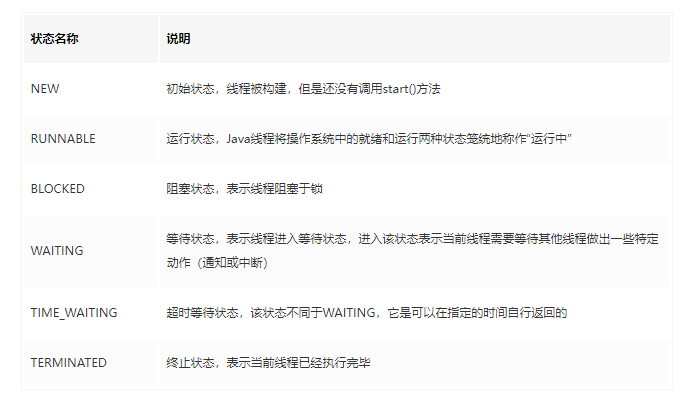您好,登錄后才能下訂單哦!
您好,登錄后才能下訂單哦!
這篇文章主要為大家展示了“Java多線程基礎知識點有哪些”,內容簡而易懂,條理清晰,希望能夠幫助大家解決疑惑,下面讓小編帶領大家一起研究并學習一下“Java多線程基礎知識點有哪些”這篇文章吧。
什么是線程:
線程是進程的一個實體,是CPU調度和分派的基本單位,它是比進程更小的能獨立運行的基本單位。
什么是多線程:
多線程指在單個程序中可以同時運行多個不同的線程執行不同的任務。
多線程的創建方式有三種:Thread、Runnable、Callable
Thread thread = new Thread() {
@Override
public void run() {
super.run();
while (true) {
try {
Thread.sleep(500);
} catch (InterruptedException e) {
e.printStackTrace();
}
System.out.println("1:" + Thread.currentThread().getName());
System.out.println("2:" + this.getName());
}
}
};
thread.start();Thread thread1 = new Thread(new Runnable() {
@Override
public void run() {
while (true) {
try {
Thread.sleep(500);
} catch (InterruptedException e) {
e.printStackTrace();
}
System.out.println("3:" + Thread.currentThread().getName());
}
}
});
thread1.start();public class CallableTest {
public static void main(String[] args) {
System.out.println("當前線程是:" + Thread.currentThread());
Callable myCallable = new Callable() {
@Override
public Integer call() throws Exception {
int i = 0;
for (; i < 10; i++) {
}
//當前線程
System.out.println("當前線程是:" + Thread.currentThread()
+ ":" + i);
return i;
}
};
FutureTask<Integer> fu = new FutureTask<Integer>(myCallable);
Thread th = new Thread(fu, "callable thread");
th.start();
//得到返回值
try {
System.out.println("返回值是:" + fu.get());
} catch (Exception e) {
e.printStackTrace();
}
}
}當前線程是:Thread[main,5,main]
當前線程是:Thread[callable thread,5,main]:10
返回值是:10
總結:
實現Runnable接口相比繼承Thread類有如下優勢:
可以避免由于Java的單繼承特性而帶來的局限;
增強程序的健壯性,代碼能夠被多個線程共享,代碼與數據是獨立的;
適合多個相同程序代碼的線程區處理同一資源的情況。
實現Runnable接口和實現Callable接口的區別:
Runnable是自從java1.1就有了,而Callable是1.5之后才加上去的
Callable規定的方法是call() , Runnable規定的方法是run()
Callable的任務執行后可返回值,而Runnable的任務是不能返回值是(void)
call方法可以拋出異常,run方法不可以
運行Callable任務可以拿到一個Future對象,表示異步計算的結果。它提供了檢查計算是否完成的方法,以等待計算的完成,并檢索計算的結果。通過Future對象可以了解任務執行情況,可取消任務的執行,還可獲取執行結果。
加入線程池運行,Runnable使用ExecutorService的execute方法,Callable使用submit方法。

Join線程的運行順序
原理:
import java.util.Timer;
import java.util.TimerTask;
public class TraditionalTimerTest {
public static void main(String[] args) {
// new Timer().schedule(new TimerTask() {
// @Override
// public void run() {
//
// System.out.println("bombing!");
// }
// },10000);
class MyTimberTask extends TimerTask {
@Override
public void run() {
System.out.println("bombing!");
new Timer().schedule(new MyTimberTask(), 2000);
}
}
new Timer().schedule(new MyTimberTask(), 2000);
int count = 0;
while (true) {
System.out.println(count++);
try {
Thread.sleep(1000);
} catch (InterruptedException e) {
e.printStackTrace();
}
}
}
}0
1
bombing!
2
3
bombing!
4
5
bombing!
6
省略...
public class TraditionalThreadSynchronized {
public static void main(String[] args) {
new TraditionalThreadSynchronized().init();
}
private void init() {
final Outputer outputer = new Outputer();
new Thread(new Runnable() {
@Override
public void run() {
while (true) {
try {
Thread.sleep(10);
} catch (InterruptedException e) {
e.printStackTrace();
}
outputer.output("kpioneer");
}
}
}).start();
// new Thread(new Runnable() {
// @Override
// public void run() {
//
// while (true) {
// try {
// Thread.sleep(10);
// } catch (InterruptedException e) {
// e.printStackTrace();
// }
// outputer.output2("Tom");
//
// }
// }
// }).start();
new Thread(new Runnable() {
@Override
public void run() {
while (true) {
try {
Thread.sleep(10);
} catch (InterruptedException e) {
e.printStackTrace();
}
outputer.output3("Jack");
}
}
}).start();
}
static class Outputer {
public void output(String name) {
int len = name.length();
synchronized (Outputer.class) {
for (int i = 0; i < len; i++) {
System.out.print(name.charAt(i));
}
System.out.println();
}
}
public synchronized void output2(String name) {
int len = name.length();
for (int i = 0; i < len; i++) {
System.out.print(name.charAt(i));
}
System.out.println();
}
public static synchronized void output3(String name) {
int len = name.length();
for (int i = 0; i < len; i++) {
System.out.print(name.charAt(i));
}
System.out.println();
}
}
}子線程循環10次,接著主線程循環100,接著又回到子線程循環10次,接著再回到主線程有循環100,如此循環50次,請寫出程序。
public class TraditionalThreadCommunication {
public static void main(String[] args) {
final Business business = new Business();
new Thread(new Runnable() {
@Override
public void run() {
for (int i = 1; i <= 50; i++) {
business.sub(i);
}
}
}
).start();
for (int i = 1; i <= 50; i++) {
business.main(i);
}
}
}
/**
*要用到共同數據(包括同步鎖)的若干方法應該歸在同一個類身上,
* 這種設計正好體現了高類聚和和程序的健壯性
*/
class Business {
private boolean bShouldSub = true;
public synchronized void sub(int i) {
if(!bShouldSub) {
try {
this.wait();
} catch (InterruptedException e) {
e.printStackTrace();
}
}
for (int j = 1; j <= 10; j++) {
System.out.println("sub thread sequece of " + j + ",loop of " + i);
}
bShouldSub = false;
this.notify();
}
public synchronized void main(int i) {
if(bShouldSub) {
try {
this.wait();
} catch (InterruptedException e) {
e.printStackTrace();
}
}
for (int j = 1; j <=100; j++) {
System.out.println("main thread sequece of " + j + ",loop of " + i);
}
bShouldSub = true;
this.notify();
}
}sub thread sequece of 1,loop of 1
sub thread sequece of 2,loop of 1
sub thread sequece of 3,loop of 1
sub thread sequece of 4,loop of 1
sub thread sequece of 5,loop of 1
sub thread sequece of 6,loop of 1
sub thread sequece of 7,loop of 1
sub thread sequece of 8,loop of 1
sub thread sequece of 9,loop of 1
sub thread sequece of 10,loop of 1
main thread sequece of 1,loop of 1
main thread sequece of 2,loop of 1
main thread sequece of 3,loop of 1
main thread sequece of 4,loop of 1
main thread sequece of 5,loop of 1
main thread sequece of 6,loop of 1
main thread sequece of 7,loop of 1
main thread sequece of 8,loop of 1
main thread sequece of 9,loop of 1
main thread sequece of 10,loop of 1
main thread sequece of 11,loop of 1
省略中間...
main thread sequece of 99,loop of 1
main thread sequece of 100,loop of 1
sub thread sequece of 1,loop of 2
sub thread sequece of 2,loop of 2
sub thread sequece of 3,loop of 2
sub thread sequece of 4,loop of 2
sub thread sequece of 5,loop of 2
sub thread sequece of 6,loop of 2
sub thread sequece of 7,loop of 2
sub thread sequece of 8,loop of 2
sub thread sequece of 9,loop of 2
sub thread sequece of 10,loop of 2
main thread sequece of 1,loop of 2
main thread sequece of 2,loop of 2
main thread sequece of 3,loop of 2
省略...
以上是“Java多線程基礎知識點有哪些”這篇文章的所有內容,感謝各位的閱讀!相信大家都有了一定的了解,希望分享的內容對大家有所幫助,如果還想學習更多知識,歡迎關注億速云行業資訊頻道!
免責聲明:本站發布的內容(圖片、視頻和文字)以原創、轉載和分享為主,文章觀點不代表本網站立場,如果涉及侵權請聯系站長郵箱:is@yisu.com進行舉報,并提供相關證據,一經查實,將立刻刪除涉嫌侵權內容。